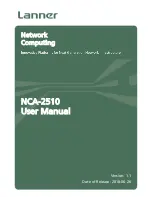
Installing the FortiGate unit
Connecting to the FortiGate unit
FortiGate-50A/50B, FortiWiFi-50B and FortiGate-100 FortiOS 3.0 MR4 Install Guide
01-30004-0265-20070831
23
Command line interface
You can access the FortiGate command line interface (CLI) by connecting a
management computer serial port to the FortiGate serial console connector. You
can also use Telnet or a secure SSH connection to connect to the CLI from any
network that is connected to the FortiGate unit, including the Internet.
The CLI supports the same configuration and monitoring functionality as the
web-based manager. In addition, you can use the CLI for advanced configuration
options that are not available from the web-based manager. This guide contains
information about basic and advanced CLI commands. For a more complete
description about connecting to and using the FortiGate CLI, see the
FortiGate
CLI Reference
.
Connecting to the CLI
As an alternative to the web-based manager, you can install and configure the
FortiGate unit using the CLI. Configuration changes made with the CLI are
effective immediately, without resetting the firewall or interrupting service.
To connect to the FortiGate CLI you require:
• a computer with an available communications port
• the RJ-45 to DB-9 serial cable or null-modem cable included in your FortiGate
package.
• terminal emulation software such as HyperTerminal for Microsoft Windows.
To connect to the CLI
1
Connect the RJ-45 to DB-9 serial cable or null-modem cable to the
communications port of your computer and to the FortiGate Console port.
2
Start HyperTerminal, enter a name for the connection and select OK.
3
Configure HyperTerminal to connect directly to the communications port on your
computer and select OK.
4
Select the following port settings and select OK.
5
Press Enter to connect to the FortiGate CLI.
The login prompt appears.
6
Type
admin
and press Enter twice.
The following prompt is displayed:
Welcome!
Type ? to list available commands. For information about how to use the CLI, see
the
FortiGate CLI Reference
.
Note:
The following procedure uses Microsoft Windows HyperTerminal software. You can
apply these steps to any terminal emulation program.
Bits per second
9600
Data bits
8
Parity
None
Stop bits
1
Flow control
None
Summary of Contents for Fortigate 100D
Page 83: ...www fortinet com ...
Page 84: ...www fortinet com ...




































